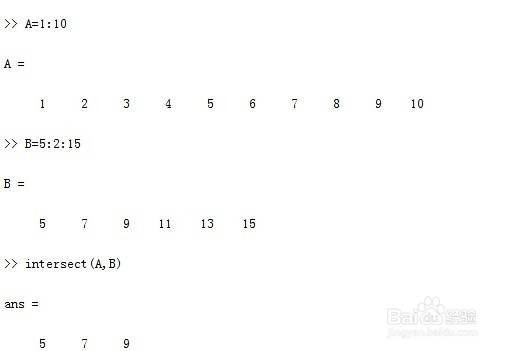利用Matlab进行交集、并集等运算
1、帮助文档:
intersect Set intersection.
C = intersect(A,B) for vectors A and B, returns the values common to
the two vectors with no repetitions. C will be sorted.
C = intersect(A,B,'rows') for matrices A and B with the same
number of columns, returns the rows common to the two matrices. The
rows of the matrix C will be in sorted order.
[C,IA,IB] = intersect(A,B) also returns index vectors IA and IB such
that C = A(IA) and C = B(IB). If there are repeated common values in
A or B then the index of the last occurrence of each repeated value is
returned.
[C,IA,IB] = intersect(A,B,'rows') also returns index vectors IA and IB
such that C = A(IA,:) and C = B(IB,:).
[C,IA,IB] = intersect(A,B,'stable') for arrays A and B, returns the
values of C in the same order that they appear in A.
[C,IA,IB] = intersect(A,B,'sorted') returns the values of C in sorted
order.
If A and B are row vectors, then C will be a row vector as well,
otherwise C will be a column vector. IA and IB are column vectors.
If there are repeated common values in A or B then the index of the
first occurrence of each repeated value is returned.
[C,IA,IB] = intersect(A,B,'rows','stable') returns the rows of C in the
same order that they appear in A.
[C,IA,IB] = intersect(A,B,'rows','sorted') returns the rows of C in
sorted order.
In a future release, the behavior of the following syntaxes will change
including:
- occurrence of indices in IA and IB will switch from last to first
- orientation of vector C
- IA and IB will always be column index vectors
- tighter restrictions on combinations of classes
In order to see what impact those changes will have on your code, use:
[C,IA,IB] = intersect(A,B,'R2012a')
[C,IA,IB] = intersect(A,B,'rows','R2012a')
If the changes in behavior adversely affect your code, you may preserve
the current behavior with:
[C,IA,IB] = intersect(A,B,'legacy')
[C,IA,IB] = intersect(A,B,'rows','legacy')
Examples:
a = [9 9 9 9 9 9 8 8 8 8 7 7 7 6 6 6 5 5 4 2 1]
b = [1 1 1 3 3 3 3 3 4 4 4 4 4 10 10 10]
[c1,ia1,ib1] = intersect(a,b)
% returns
c1 = [1 4], ia1 = [21 19], ib1 = [3 13]
[c2,ia2,ib2] = intersect(a,b,'stable')
% returns
c2 = [4 1], ia2 = [19 21]', ib2 = [9 1]'
c = intersect([1 NaN 2 3],[3 4 NaN 1])
% NaNs compare as not equal, so this returns
c = [1 3]
Class support for inputs A and B, where A and B must be of the same
class unless stated otherwise:
- logical, char, all numeric classes (may combine with double arrays)
- cell arrays of strings (may combine with char arrays)
-- 'rows' option is not supported for cell arrays
- objects with methods SORT (SORTROWS for the 'rows' option), EQ and NE
-- including heterogeneous arrays derived from the same root class
2、简单示例:集合A:
A =
1 2 3 4 5 6 7 8 9 10
集合B:
> B=5:2:15
B =
5 7 9 11 13 15
3、求A∩B为:intersect(A,B)

1、setdiff Set difference.
C = setdiff(A,B) for vectors A and B, returns the values in A that
are not in B with no repetitions. C will be sorted.
C = setdiff(A,B,'rows') for matrices A and B with the same number of
columns, returns the rows from A that are not in B. The rows of the
matrix C will be in sorted order.
[C,IA] = setdiff(A,B) also returns an index vector IA such that
C = A(IA). If there are repeated values in A that are not in B, then
the index of the last occurrence of each repeated value is returned.
[C,IA] = setdiff(A,B,'rows') also returns an index vector IA such that
C = A(IA,:).
[C,IA] = setdiff(A,B,'stable') for arrays A and B, returns the values
of C in the order that they appear in A.
[C,IA] = setdiff(A,B,'sorted') returns the values of C in sorted order.
If A is a row vector, then C will be a row vector as well, otherwise C
will be a column vector. IA is a column vector. If there are repeated
values in A that are not in B, then the index of the first occurrence of
each repeated value is returned.
[C,IA] = setdiff(A,B,'rows','stable') returns the rows of C in the
same order that they appear in A.
[C,IA] = setdiff(A,B,'rows','sorted') returns the rows of C in sorted
order.
In a future release, the behavior of the following syntaxes will change
including:
- occurrence of indices in IA will switch from last to first
- orientation of vector C
- IA will always be a column index vector
- tighter restrictions on combinations of classes
In order to see what impact those changes will have on your code, use:
[C,IA] = setdiff(A,B,'R2012a')
[C,IA] = setdiff(A,B,'rows','R2012a')
2、例如,求上例中在集合A中,不在集合B中的元素。命令为setdiff(A,B)

1、例如setxor(A,B)=
setxor(A,B)
ans =
1 2 3 4 6 8 10 11 13 15
1、union(A,B)=
> union(A,B)
ans =
1 2 3 4 5 6 7 8 9 10 11 13 15
